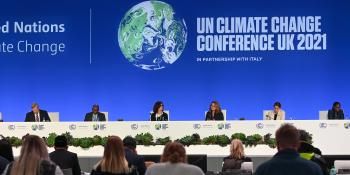Carbon and communities: innovative approaches to agriculture and forest management in Indonesia

by Peter Newton
We are standing in knee-deep, tea-colored water. “Pekerjaan kami di sini”, smiles Pak Tukul, “our work is here”. He and his colleague Pak Maryanto have led my colleague Lini and me to this spot in the flooded peat-swamp forest, wading through pools and clambering across roots and over fallen trunks. We are here to see a research plot where they have been working.
They explain that the two of them have helped to painstakingly identify and measure every tree, sapling and seedling in this 25m x 25m plot, and to measure the depth of the peat, in order to estimate the carbon contained in this patch of forest. It took us an hour by canoe, and a 15-minute wade to get to this site: they tell us that this is the most accessible of the 200-plus plots that they have surveyed.
Why all the hard work? The site is part of an innovative REDD-like project, covering a vast 204,000 hectare (Mauritius-sized) tract of forest in Central Kalimantan, just east of the regional capital of Sampit. Formerly a licensed logging concession, the forest is devoid of the largest trees, but remains otherwise intact and supports enormous biodiversity, including orangutans. A small consortium of Indonesian entrepreneurs have submitted an application to the Ministry of Forestry to operate the forest as an Ecological Restoration Concession (ERC) - a form of land classification only operational in two other sites. If successful, this test case could lead the way for a new mechanism for maintaining the environmental and socio-economic benefits of forests in Indonesia.
In Indonesia, as elsewhere in the tropics, forests and agriculture compete for space. The problems intensify when commodity crops like oil palm are involved. The financial returns from oil palm are high, and commodity agriculture provides jobs and generates GDP. Although Indonesian law prohibits most of this particular site from conversion to oil palm (because it’s peat land), the new ERC model is of interest for other sites where the pressure for conversion may be higher.
The application for an ERC at this site is part of the umbrella Katingan Project, which takes a multi-faceted approach to the complex issues facing Indonesian forests and the communities that depend on them. Ultimately, the project hopes to generate revenue by selling credits for the carbon contained in the peat forest. The 200 carefully-surveyed plots provide the data to support this scheme. At the same time, the project is working with an extensive group of partners to build strong ties with local communities, to document and monitor biodiversity, and to address the various challenges that threaten the forest’s continued integrity - threats that include illegal mining and timber extraction, and neighboring oil palm plantations, whose activities can drain the peat and increase the risk of fires.
Emerging from the forest, we spend an afternoon in the riverside village of Terantang, where Pak Tukul and Pak Maryanto live. Here, we witness an intensity of productivity rarely seen in rural communities. Many Terantang residents are actively involved in collecting and processing rattan cane for sale to traders and, ultimately, manufacture into furniture. They also earn income from small-scale agriculture, swallow-nest ‘farming’, and rubber agroforestry. The success of the Katingan Project depends on the support of local communities, and the project managers hope that by helping to support income-generating opportunities a win:win can be established for the forest and the people that use it. For example, the project is working with organizations such as POSH Salvage and Tropical Salvage to help communities to access niche rattan and salvaged timber markets. It is also supporting a new agroforestry group that plans to expand the area of community land planted with rubber - simultaneously reforesting cleared land, and generating income.

The development of ERCs in Indonesia has been ground-breaking in establishing the possibility of managing a logging concession for forest conservation and restoration, rather than for timber extraction. The only ERCs to have already been granted licenses are the 99,000 hectare Harapan Rainforest in Sumatra, and the 86,000 hectare Kehje Sewen forest in East Kalimantan. Licensed to the BirdLife NGO alliance and to the organization Restorasi Habitat Orangutan Indonesia respectively, the primary objective of both ERCs is biodiversity conservation. In contrast, the Katingan Project (and the proposed Rimba Raya Project) is applying a climate change mitigation focus to the ERC model. It looks likely that, if successful, others will follow suit.
Success may not be quick, and it certainly won’t be easy. Our short visit attested to some of the many challenges that such projects face: the daunting logistical challenge of measuring forest carbon, understanding and meeting the needs of local communities, and the lengthy process to get the concession license issued. Let alone the uncertainty of a still-distant carbon market.
That said, the management of ERCs for carbon trading may represent a tenable strategy and many people in Indonesia are optimistic about the potential for success. Several obstacles have already been overcome: the people of Terantang are largely supportive of the project and, thanks to Pak Tukul and Pak Maryanto, there are excellent estimates of forest carbon. Many eyes are on the Katingan Project and similar initiatives, and much hope for Indonesia’s forests rides on their progress and success.
Peter Newton is a CCAFS Researcher and Lini Wollenberg is the CCAFS Pro-Poor Mitigation Research Theme Leader. Peter and Lini's visit to the Katingan Project site in Central Kalimantan was part of a wider visit to Indonesia to meet with partners and to facilitate a workshop as part of the CCAFS and IFRI Governance of Mitigation in Agriculture and Forest Landscapes project.


